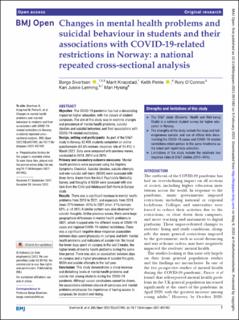| dc.description.abstract | Objective: The COVID-19 pandemic has had a devastating impact on higher education, with the closure of student campuses. The aim of this study was to examine changes and prevalence of mental health problems, suicidal ideation and suicidal behaviour, and their associations with COVID-19-related restrictions.
Design, setting and participants: As part of the SHoT-study in Norway, 62 498 students completed an online questionnaire (65.6% women; response rate of 34.4%) in March 2021. Data were compared with previous waves, conducted in 2018, 2014 and 2010.
Primary and secondary outcome measures: Mental health problems were assessed using the Hopkins Symptoms Checklist. Suicidal ideation, suicide attempts and non-suicidal self-harm (NSSH) were assessed with three items drawn from the Adult Psychiatric Morbidity Survey, and thoughts of NSSH were assessed with one item from the Child and Adolescent Self-Harm in Europe study.
Results: There was a significant increase in mental health problems from 2010 to 2021, and especially from 2018 (men: 27%/women: 45%) to 2021 (men: 41%/women: 62%, p <0.001). A similar pattern was also observed for suicidal thoughts. Unlike previous waves, there were large geographical differences in mental health problems in 2021, which mapped onto the different levels of COVID-19 cases and regional COVID-19-related restrictions. There was a significant negative dose–response association between days spent physically on campus and both mental health problems and indicators of suicide risk. We found the fewer days spent on campus in the last 2 weeks, the higher levels of mental health problems during the same time period. There was also an association between days on campus and a higher prevalence of suicidal thoughts, NSSH and suicide attempts in the last year.
Conclusion: This study demonstrates a sharp increase and disturbing levels of mental health problems and suicide risk among students during the COVID-19 pandemic. Although causal conclusions cannot be drawn, the associations between closure of campuses and mental problems emphasise the importance of having access to campuses for student well-being. | en_US |

